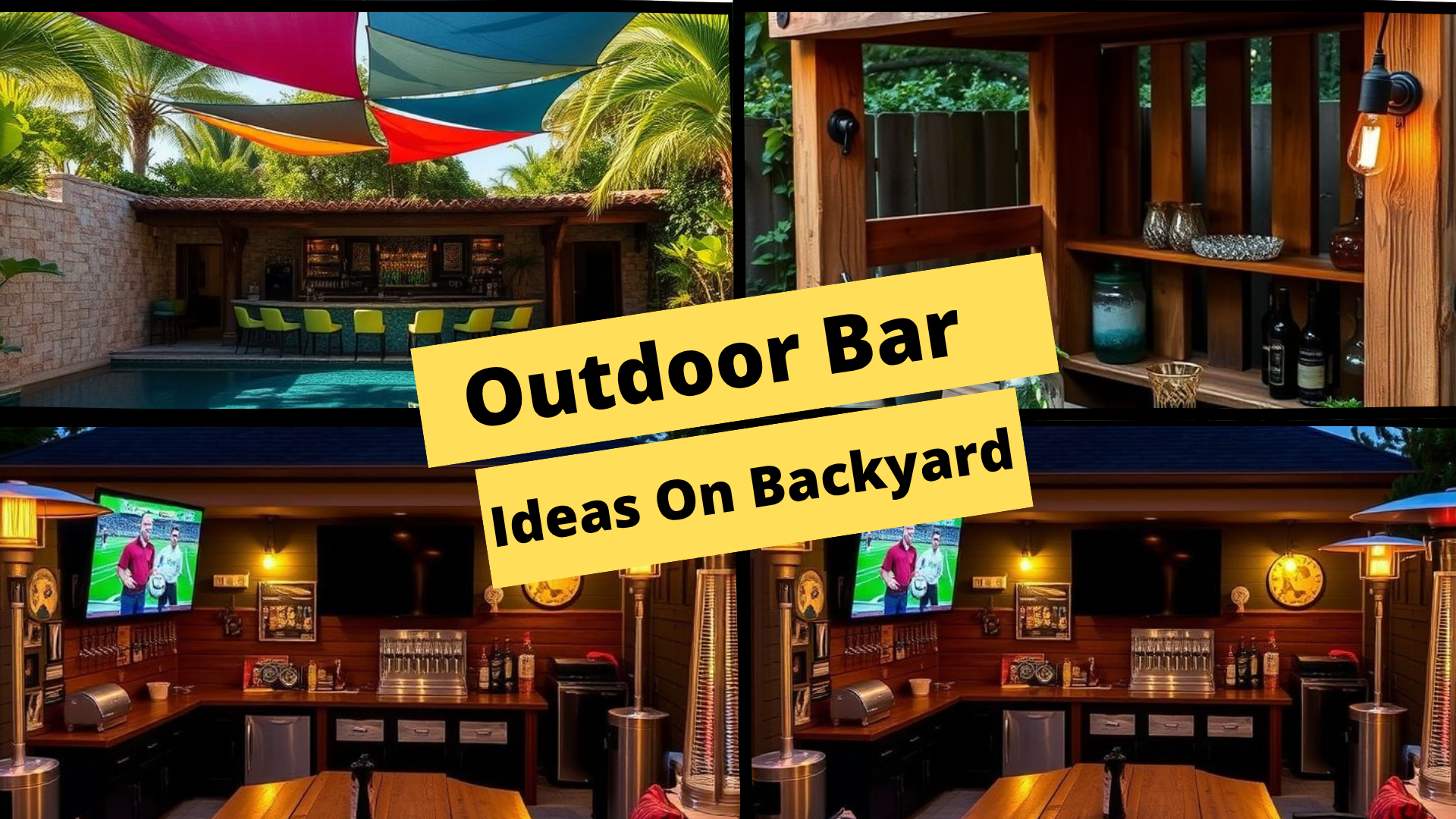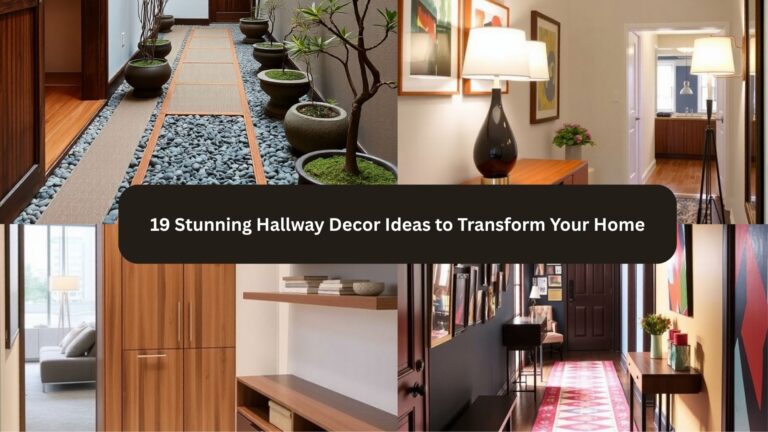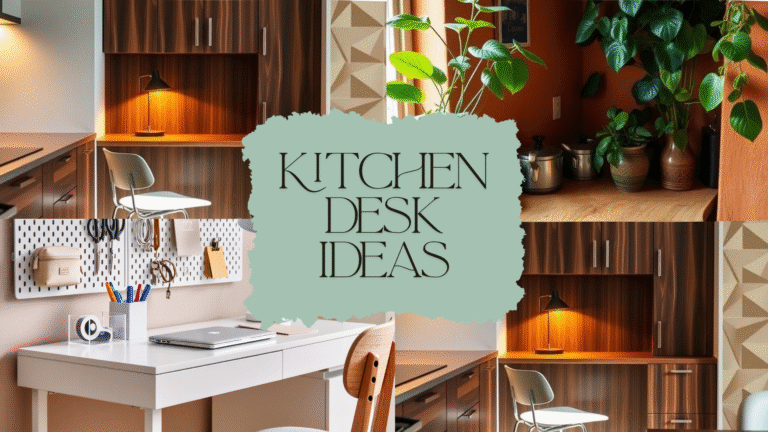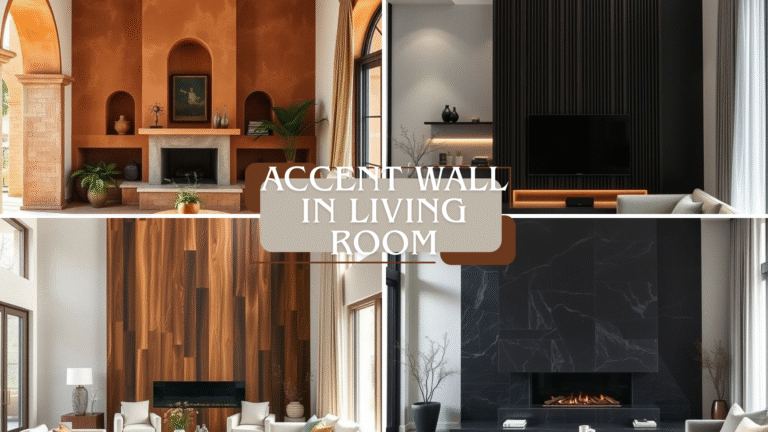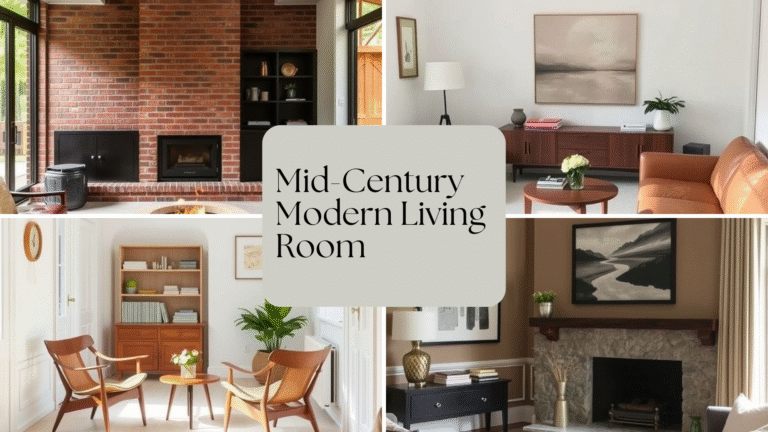Outdoor Bar Ideas On Backyard: 20 Stylish Setups
Outdoor Bar Ideas On Backyard: 20 Stylish Setups
A well-designed outdoor bar turns any backyard into the go-to gathering spot—equal parts lounge, kitchen, and mini resort. The key is balancing atmosphere with function: sightlines to the yard, comfortable seating, weatherproof finishes, and smart storage so hosting feels effortless. Below are the first five concepts, each broken down into 6–7 short, practical paragraphs to help you plan and build with confidence.
1) Backyard Bar and Lounge With Fire Pit Centerpiece
A circular or square fire pit centered in the lounge creates an instant focal point and naturally organizes seating into a conversational “ring.” Place the bar itself just beyond the heat zone—about 8–10 feet back—so bartenders and guests can move freely without feeling the blast. If space allows, use a U-shaped sectional or four club chairs with a low-profile table for setting down plates and cocktails.
Choose a fire feature that suits your style and climate. Gas fire pits offer on-demand ambiance, clean flames, and easier control; wood delivers crackle and aroma but needs spark screens and ash cleanup. Build with non-combustible materials like concrete, stone, steel, or fire-rated pavers, and keep soft goods (pillows, throws) outside the flame’s radiant range.
Define traffic paths early. Keep a clear route between kitchen door, bar, and seating so servers aren’t squeezing behind chairs. A 36–42 inch aisle behind bar stools feels comfortable; add drink rails along the lounge edge so people standing have a place to park a glass.
Layer lighting to match the mood. Combine path lights for safety, low-glow seat wall lights for depth, and dimmable sconces or pendants at the bar for task work. Under-counter LEDs highlight stone textures and make the bar look polished after dark.
Prioritize comfort that can handle heat. Opt for solution-dyed acrylic cushions, ceramic or stone side tables that won’t scorch, and a few wool or fire-resistant throws for shoulder season. Hidden storage under benches keeps blankets, marshmallow skewers, and matches within reach.
Don’t skip the safety checklist. Verify local codes, gas line placement, and clearances from structures and trees. Add a shut-off valve, a sturdy cover for when the pit’s not in use, and a discrete fire extinguisher cabinet near the bar.

2) Backyard Garden Bar With Vertical Herb Wall
A vertical herb wall turns your bar into a living garnish station and a fragrant privacy screen. Mount modular planters or slatted racks behind the back bar, leaving 18–24 inches of working clearance so you can snip basil, mint, and thyme on the fly. Situate the wall for 4–6 hours of sun, or choose shade-tolerant herbs if your exposure is softer.
Design the bar top for prep. Include a built-in cutting board, a rinse sink with a pull-down faucet, and a perforated bin for stems. Small baskets or magnetic tins keep citrus, bitters, and herb sprigs organized, while a narrow upper shelf displays syrups and labeled bottles.
Plan irrigation from day one. Drip lines on timers keep moisture consistent without splashing the counter; a gutter at the base of the wall can recapture runoff into a reservoir. Use high-quality potting mix with perlite for drainage and refresh soil seasonally to prevent compaction.
Mix textures for visual richness. Powder-coated steel frames, cedar slats, terracotta pockets, and matte black hardware create a layered look that still reads cohesive. Keep the palette earthy—greens, woods, blacks—and let the herbs provide the color.
Think seasonality and rotation. Cluster heat lovers (basil, rosemary) together and cool-season stars (parsley, cilantro) in their own row so you can swap trays as weather changes. Keep neem oil or insecticidal soap handy for gentle, food-safe pest control.
Elevate the experience with scent-driven cocktails. Post a small chalk sign listing “garden specials” like rosemary gin fizz or grapefruit-thyme spritz. Add a few edible flowers—nasturtium, borage, viola—for garnish that doubles as conversation starter.
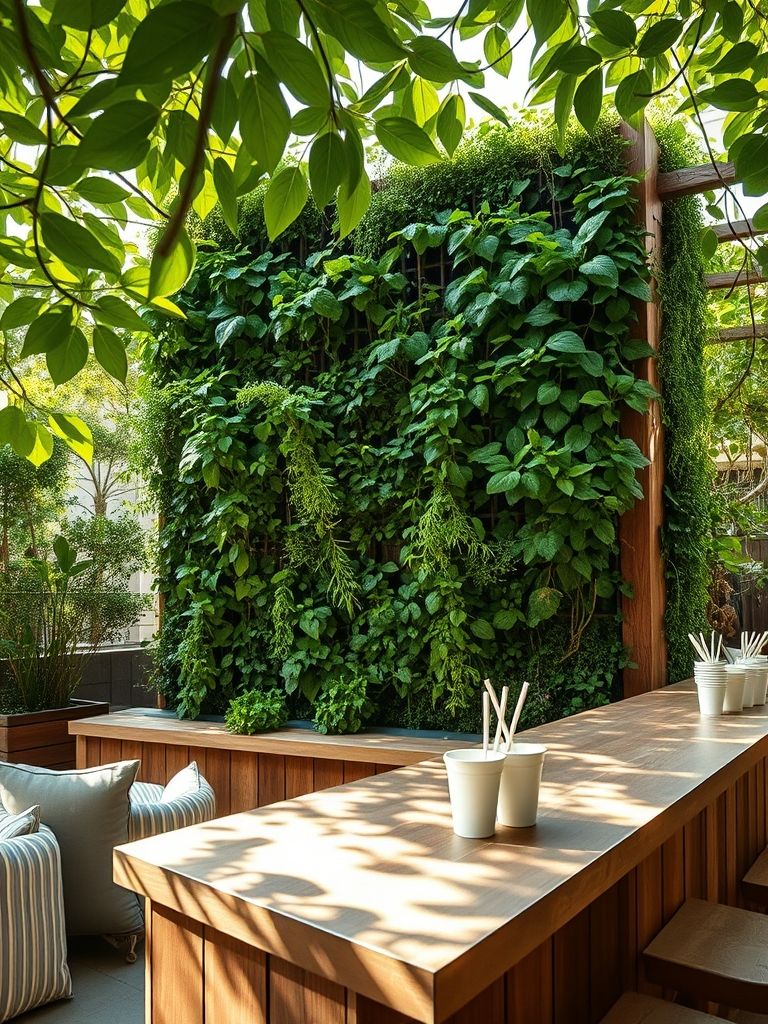
3) Boho-Chic Outdoor Bar With Macramé and Wicker Decor
Lean into a relaxed, layered aesthetic that feels collected over time. Start with a neutral base—whitewashed walls, natural wood tops—and add warmth via rattan stools, wicker lounge chairs, and a chunky macramé wall hanging behind the back bar to soften hard lines.
Choose materials that handle the elements. Look for all-weather wicker with UV-resistant resin, marine-grade rope for macramé (or bring hangings inside between uses), and fade-resistant textiles in earthy tones: sand, rust, olive, and indigo. Outdoor rugs with a flat-weave pattern add texture without trapping moisture.
Keep seating low and loungy to suit the vibe. Floor cushions, poufs, and a low coffee table create casual zones where guests can perch with mezze boards. Balance the softness with a sturdy, waist-high bar for shaking and pouring without hunching.
Create a glow with mixed lighting. String lights overhead for a canopy effect, add lanterns at varied heights, and tuck a few solar stake lights into planters. Candle-style LEDs inside frosted glass cylinders give flicker without worrying about wind.
Embrace eclectic accessories. Layer patterned throws, woven trays, handmade ceramics for garnish bowls, and a vintage bar cart for mobile service. A simple peg rail can display macramé plant holders, strainers, and bar towels like art.
Plan for care and storage. Use cushion bins or a deck box to stash textiles during rain, secure light objects before windy nights, and spot-clean wicker with mild soap. A breathable cover over the main bar extends the life of the finish between entertaining days.
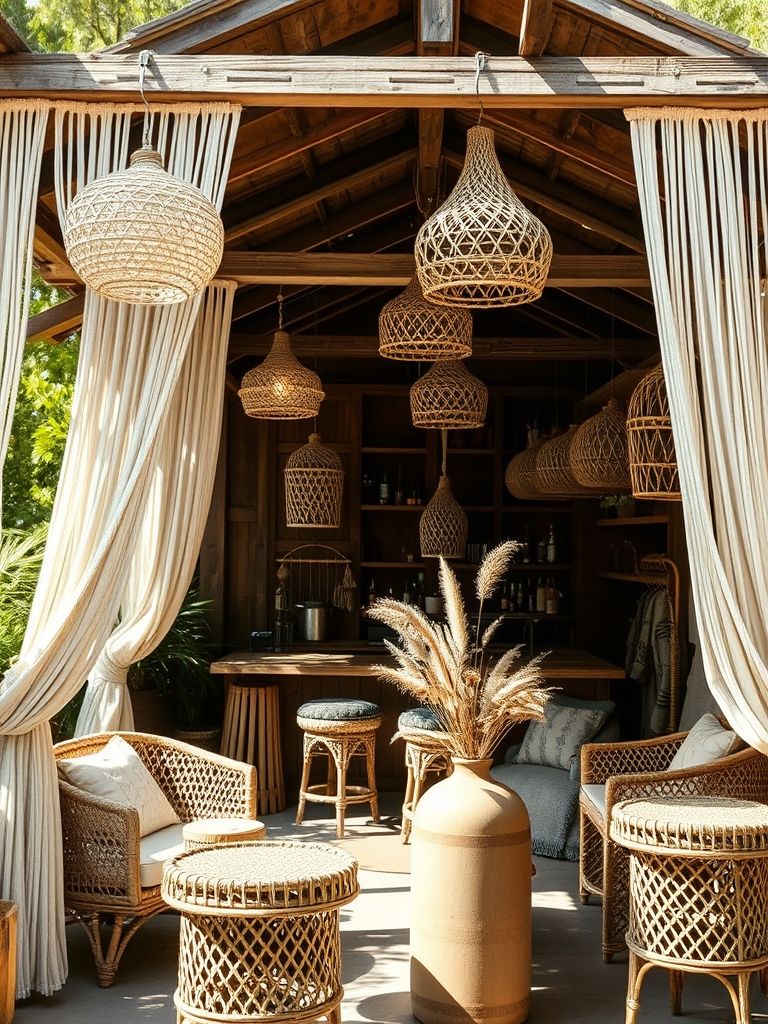
4) Cabana Bar With Flowing Drapes and Tropical Plants
Channel resort energy with a four-post cabana or pergola framing the bar. Mount ceiling rods or tension wires and hang outdoor drapes with weighted hems so they billow, not tangle. Tie-backs let you control sun, wind, and sightlines depending on the time of day.
Invest in performance fabrics. Solution-dyed acrylic curtains resist UV, mildew, and fading; choose off-white, sand, or soft taupe for a bright, airy feel that won’t glare. Black or bronze hardware disappears visually and keeps the look elevated.
Create a lush perimeter with plants. Cluster potted palms, bird-of-paradise, philodendron, and monstera in oversized, self-watering planters to build a leafy backdrop. If your climate runs cool, use hardy tropical look-alikes (like hardy banana or needle palm) and wheel pots inside during cold snaps.
Engineer comfort. A ceiling fan, misting line, or portable evaporative cooler can drop perceived temperature on hot afternoons. Orient the cabana to capture prevailing breezes, and add a slatted privacy panel on the sunniest side to cut glare while preserving airflow.
Equip the bar like a mini hotel. Include an ice well, undercounter fridge, pull-out trash, and a towel cubby. A narrow pass-through shelf on the guest side is perfect for tapas plates and keeps the main counter clear for mixing.
Set the night scene. Uplight palms for dramatic shadows, add warm pendants over the bar, and line the platform with soft step lights. A discreet citronella diffuser or fan-mounted repellent helps minimize mosquitos without spoiling the aroma of your cocktails.

5) Converted Shipping Container Bar Lounge
Start with a sound container—ideally “one-trip” or wind- and water-tight—then check local regulations for placement, setbacks, and utility hookups. Decide early if the container stays whole, becomes a kiosk with a flip-up service window, or opens fully with bifold doors to blur indoors and out.
Cut smart and insulate well. Frame openings for a panoramic serving window and an entry door, then add closed-cell foam insulation to control heat transfer and condensation. A foil-faced vapor barrier plus mini-split HVAC keeps the interior comfortable across seasons.
Choose durable finishes that honor the industrial shell. Keep the exterior corrugation visible and paint in a matte coastal or charcoal tone; inside, line walls with plywood or tongue-and-groove, and use sealed concrete or composite plank underfoot. Black steel shelving and reclaimed wood counters complete the look.
Plan utilities with serviceability in mind. Surface-mount conduit for a clean, intentional aesthetic and easy access. Include GFCI outlets at the bar, LED strips under shelves, and task lighting over the sink. If you’re adding a handwash or prep sink, route plumbing to a frost-safe line or install a self-contained system.
Design the bar workflow like a tiny restaurant. Position the fridge and ice well within arm’s reach, add a kegerator or nitro coffee tap if you entertain often, and dedicate a tall cabinet for glassware and dry goods. A fold-down steel awning can shade the serving window and double as a rain guard.
Expand the footprint with decking. A platform with built-in benches, planters, and a shade sail creates a generous lounge zone beside the container. For security, add rolling shutters on the window and a steel door; for branding, apply a custom logo or paint band along the corrugation.

6) DIY Backyard Pallet Bar With Solar Lights
Start with heat-treated or stamped pallets (HT/EPAL) to ensure they’re safe for outdoor use. Disassemble one pallet for slats and keep two intact for the front and sides. Sand everything smooth, round over edges with 120–180 grit, and pre-drill to prevent splitting when you reassemble.
Build a rigid frame so the bar doesn’t wobble. Use pressure-treated 2×4s for a simple rectangle, add a center support, then sheath with pallet slats in a staggered pattern for a reclaimed look. Cap the top with a sealed plywood substrate before adding your final counter surface.
Choose a weatherproof counter that’s easy to clean. Exterior-grade butcher block sealed with marine varnish feels warm and classic, while cement board plus large-format porcelain tile delivers a hardwearing, modern finish. Add a 1–2 inch overhang for drip control and stool comfort.
Integrate storage where it matters. Install a hinged front door or side panels for access to a crate-style shelf, add a wire rack for bottles, and tuck a compact cooler or beverage tub beneath the counter. A magnetic strip for openers and bar tools keeps essentials visible and tidy.
Wire-free lighting is the secret sauce. Run a string of warm white solar Edison bulbs along a simple 4×4 post frame, then add adhesive solar puck lights under the counter lip for glow. A small solar motion light at the footrest improves nighttime safety without cables.
Protect and personalize. Finish the wood with a UV-resistant exterior stain, screw on angle brackets for extra rigidity, and mount a chalkboard for nightly specials. If your bar will stay out year-round, add locking casters to roll it under a covered area during heavy storms.
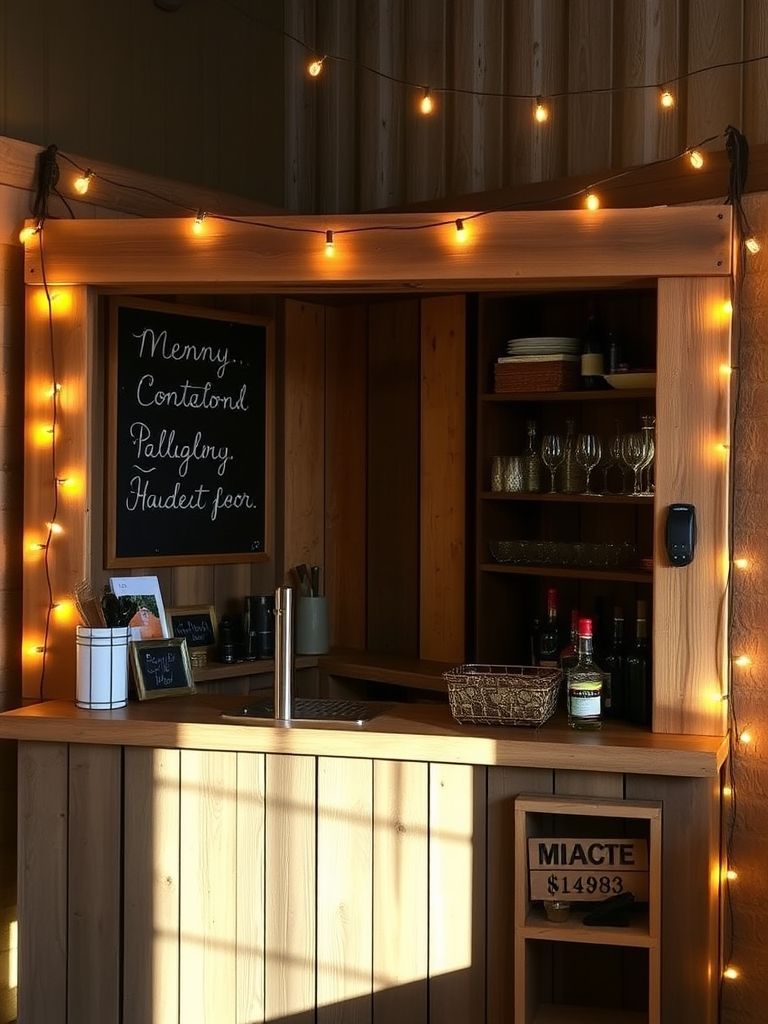
7) Farmhouse-Style Outdoor Bar With Galvanized Metal and Barnwood
Lean into honest materials and straightforward joinery. Create a plinth of stacked barnwood planks, then wrap the bar face with corrugated galvanized metal trimmed in black angle iron for a crisp, rustic–industrial blend that shrugs off weather.
Balance rugged textures with smooth touch points. A thick, edge-laminated barnwood top—planed flat and sealed with food-safe, exterior-grade oil—feels substantial and invites lingering. Add a foot rail in matte black steel pipe to echo the metal wrap and improve ergonomics.
Organize the back bar like a country pantry. Open shelves in lightly distressed pine hold mason jars of garnishes, enamel pitchers, and napkins, while a sliding barn door hides the mini fridge and cleaning supplies. Woven baskets corral snacks and spare linens.
Choose hardware that patinas gracefully. Hot-dipped galvanized screws, blackened lag bolts, and farmhouse pulls look better with age and are easy to replace. If you like a brighter note, introduce antique brass in small doses—hooks, bell, bottle opener—for warmth without clutter.
Keep the palette grounded. Whites, charcoals, honey wood tones, and galvanized gray read classic and timeless. A pop of heritage color—sage, wagon red, or deep navy—on stools or a shiplap backdrop adds personality without breaking the style rulebook.
Round things out with farmhouse comforts. Hang a gooseneck light over the counter, set a few plaid throws in a crate for chilly evenings, and plant herbs in galvanized tubs along the base. A bell on the end cap is a playful, on-theme cue for “last call.”

8) Fold-Out Murphy Bar on Backyard Fence
Turn a bare fence panel into a compact hospitality station. Mount a wall cabinet between posts, then hinge a sturdy front panel that folds down into a serving shelf. When closed, it reads like clean millwork; when open, it becomes a mini bar with real counter space.
Engineer the fold-down to feel solid. Use heavy-duty stainless strap hinges along the bottom edge and adjustable chains or folding shelf brackets to set the open angle at 90 degrees. A magnetic or keyed latch at the top keeps it secure when not in use.
Design the interior like a bento box. Shallow shelves for glassware, a narrow rail for bitters and syrups, and a mini cutting board that slides out from a slot make prep feel intentional. A removable tray lets you carry garnishes and tools to the dining area in one trip.
Mind the fence itself. Add a backing board that spans at least two studs or posts and fasten with exterior-rated lag screws to distribute weight. If your fence faces neighbors, keep the unit within your property line and confirm HOA or local rules before installation.
Weatherproof every surface. Use marine plywood, seal edges with epoxy or penetrating sealer, and finish with exterior paint or spar varnish. A shallow drip cap above the cabinet sheds rain, while compressible weatherstripping at the door helps keep dust out.
Keep power optional and tidy. If you skip hard wiring, tuck a rechargeable LED bar under the cabinet and a battery-powered puck inside for visibility. Store a compact USB pump for water and a roll-up bar mat inside so set-up is always quick.
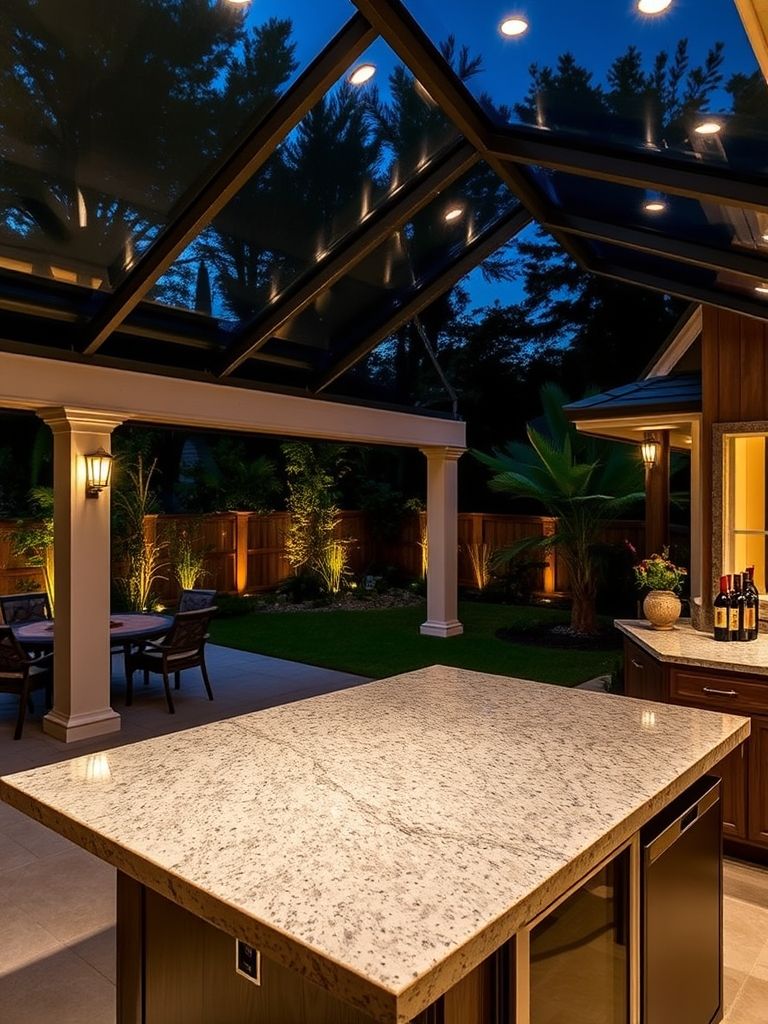
9) Industrial Backyard Bar With Exposed Brick and Pipe Shelving
Start with honest masonry. A short brick or thin-brick veneer wall creates the base and anchors the look. Choose a dark, soot-kissed mortar tone and brush the surface lightly for a timeworn feel, or keep joints clean for a sharper industrial edge.
Build shelving from black iron pipe and kiln-dried planks. Threaded pipe uprights with flanges mount to the brick and support floating shelves for bottles, glassware, and plants. Keep shelf spacing generous—12–15 inches—to accommodate tall mixers and pitchers.
Make the counter a statement. A sealed concrete slab or ultra-compact surface (like sintered stone) resists heat and stains while aligning with the industrial vibe. If you prefer warmth, use thick butcher block and pair it with steel edge banding for durability.
Light it like a converted warehouse. Add caged sconces on the brick face, an articulating task light above the sink, and a dimmable LED strip beneath the lowest shelf to silhouette bottles. If you have a canopy, a single factory-style pendant finishes the scene.
Consider the workflow. Keep the sink, ice well, and primary prep zone in a tight triangle, then place the kegerator or beverage fridge just outside that zone to prevent cross-traffic. A narrow side station for garnishes and napkins keeps the main counter clear for mixing.
Embrace small imperfections. Visible welds, mineral streaks in the wood, and uneven brick coloration add character. Seal porous surfaces with penetrating sealers to prevent stains, and use felt pads wherever metal meets stone or wood to mute clinks and scratches.
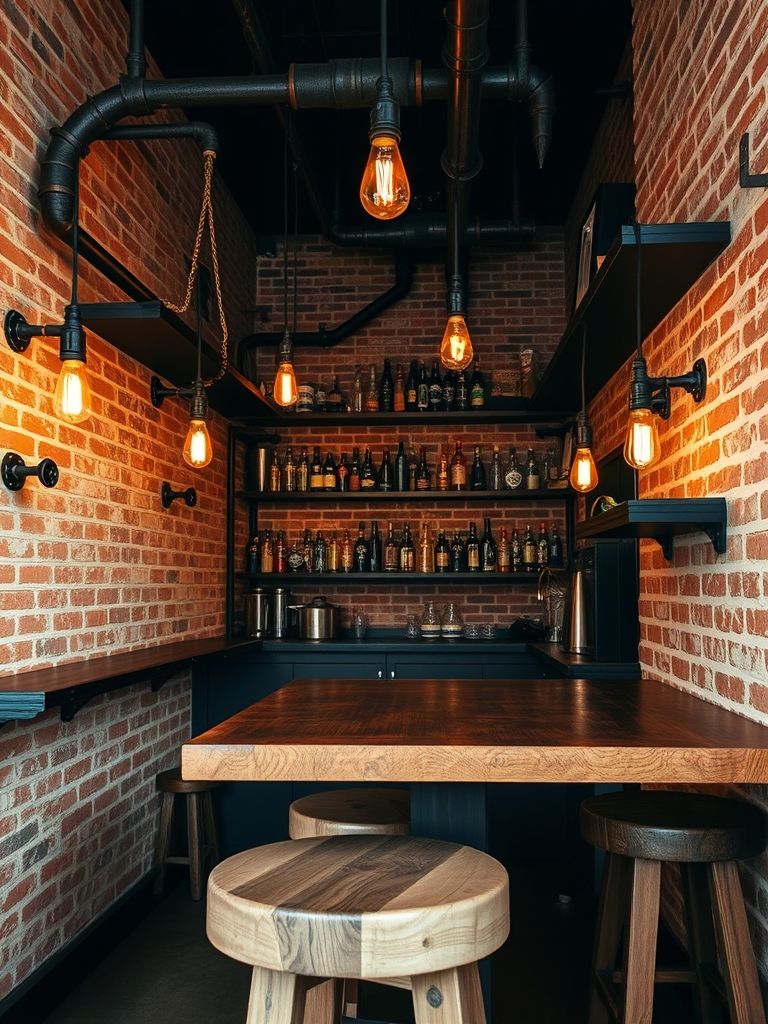
10) LED-Lit Outdoor Bar With Futuristic Vibes
Go for clean geometry and slick finishes. A monolithic bar face in smooth stucco, acrylic, or powder-coated aluminum creates a perfect canvas for light. Keep lines crisp, hardware minimal, and storage concealed for a near-seamless appearance.
Plan the lighting architecture first. Recess LED channels along toe-kicks, under-counter edges, and in vertical reveals so illumination feels integrated, not stuck on. Use outdoor-rated, IP65+ strips with aluminum diffusers to avoid hot spots and protect from moisture.
Create zones with controls. Pair warm white (2700–3000K) task lighting at the work surface with tunable RGBW accents for mood. A small, weatherproof controller lets you shift from soft amber dinner tones to party-ready color scenes with a quick preset switch.
Choose reflective but durable surfaces. Sintered stone, back-painted glass, and compact laminate counters amplify the glow and wipe clean easily. If you want a hero moment, add an acrylic lightbox panel on the bar face with a subtle pattern or your logo etched in.
Hide the tech elegantly. Route low-voltage wiring through conduit, use waterproof quick-connects for maintenance, and dedicate a ventilated compartment for drivers and a smart hub. Label runs and leave pull strings in conduits for painless future upgrades.
Finish with modern comforts. Floating stools in powder-coated metal, a slimline ice drawer, and a built-in sonic ice maker feel appropriately high-tech. Frame the area with minimalist planters and a linear fire feature to reflect off the glossy surfaces and double the drama.
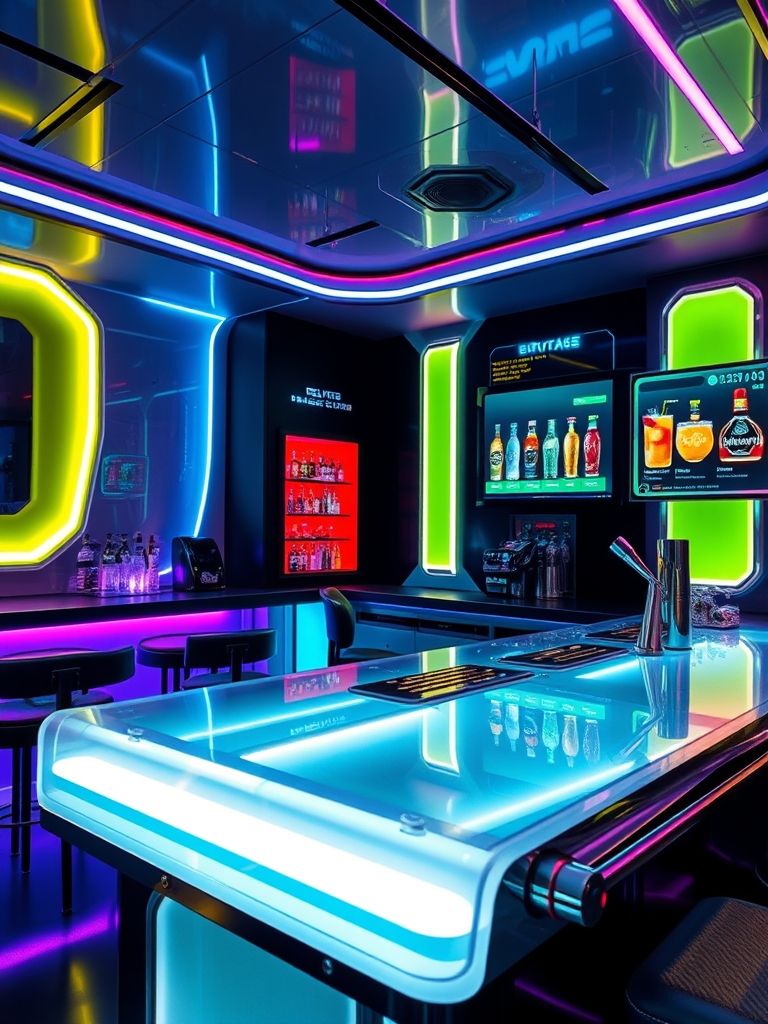
11) Luxe Backyard Bar With Glass Roof and Stone Island
A glass roof instantly elevates the bar from backyard build to boutique pavilion. Specify laminated, tempered panels on a slight pitch (2–4%) toward concealed gutters so rain sheds cleanly. A slim black or bronze aluminum frame keeps sightlines airy while providing reliable load capacity.
Plan for sun control. Low-E glass or a UV film cuts heat and glare without killing daylight; add recessed side screens or motorized fabric shades for late-afternoon angles. If your climate runs hot, a quiet ceiling fan and operable clerestory panels help vent heat naturally.
Make the island a sculpture in stone. Dense, outdoor-ready choices like granite, quartzite, or sintered porcelain resist stains and thermal shock. A waterfall edge on the guest side turns the bar into a statement, while a beveled working edge protects wrists during long prep sessions.
Finish the envelope like a luxury hotel. Hidden linear LEDs wash down stone faces, tiny puck lights sparkle under shelves, and a pair of glass pendants anchor the counter. Keep all drivers in a ventilated cabinet and put every circuit on dimmers to shift from brunch bright to nightcap glow.
Engineer a weather-smart floor. Large-format porcelain pavers or flame-finished stone add grip and drain through a slot at the perimeter. A subtle curb or recessed channel at door thresholds keeps storm splashes away from cabinetry.
Equip the back bar so service feels effortless. Undercounter fridge and ice, a tall cabinet for glassware, and a dedicated drawer for linens keep the working face clear. A discreet bar caddy with citrus, syrups, and tools lives behind a flip-down panel until showtime.
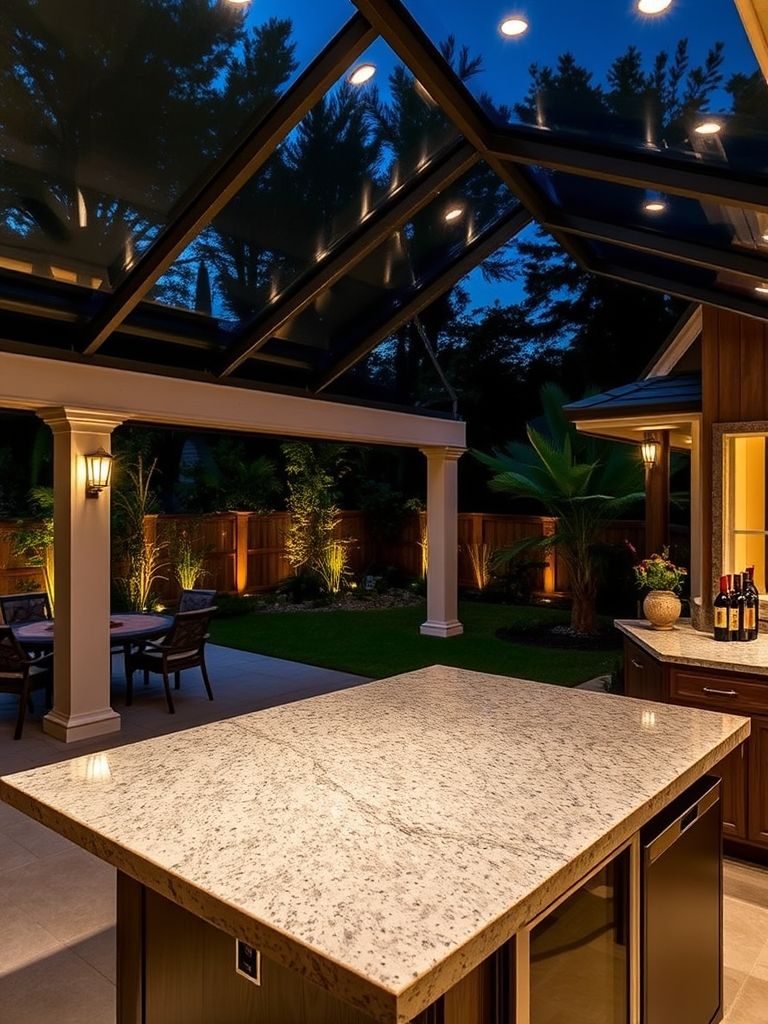
12) Minimalist White Outdoor Bar With Marble Countertop
Start with a restrained palette: matte white for millwork, soft white for walls, and a single luxurious surface on top. Honed marble is the classic, but if you want less maintenance, consider dolomite, quartzite, or porcelain that mimics marble’s veining with better stain resistance.
Build the casework to disappear. Powder-coated aluminum frames with flat slab doors resist weather and read ultra-clean; push-latch hardware removes visual clutter. Keep reveals razor-thin and run toe-kick lighting to “float” the volume at night.
Let function hide in plain sight. A drop-in ice well under a sliding panel, an integrated cutting board beside a shallow sink, and a slim trash slot behind a flap keep the work surface pristine. Use soft-close hinges and marine gaskets to seal out dust and splash.
Light with intent. Conceal LED channels beneath the counter lip for a halo and add one small, warm-white task strip directly over the prep zone. Avoid color shifts—2700–3000K across all fixtures keeps whites creamy rather than clinical.
Style sparingly. A single white ceramic vase with a clipped branch, a neat row of low rocks glasses, and a linen towel in bone or oatmeal is plenty. The marble’s movement should be the star; everything else earns its place by utility.
Maintain the finish like a ritual. Seal stone on schedule, blot spills instead of wiping, and keep a dedicated marble-safe cleaner in the top drawer. Microfiber cloths and coasters are your best friends; a removable silicone mat protects the most-used zone when you’re mixing.
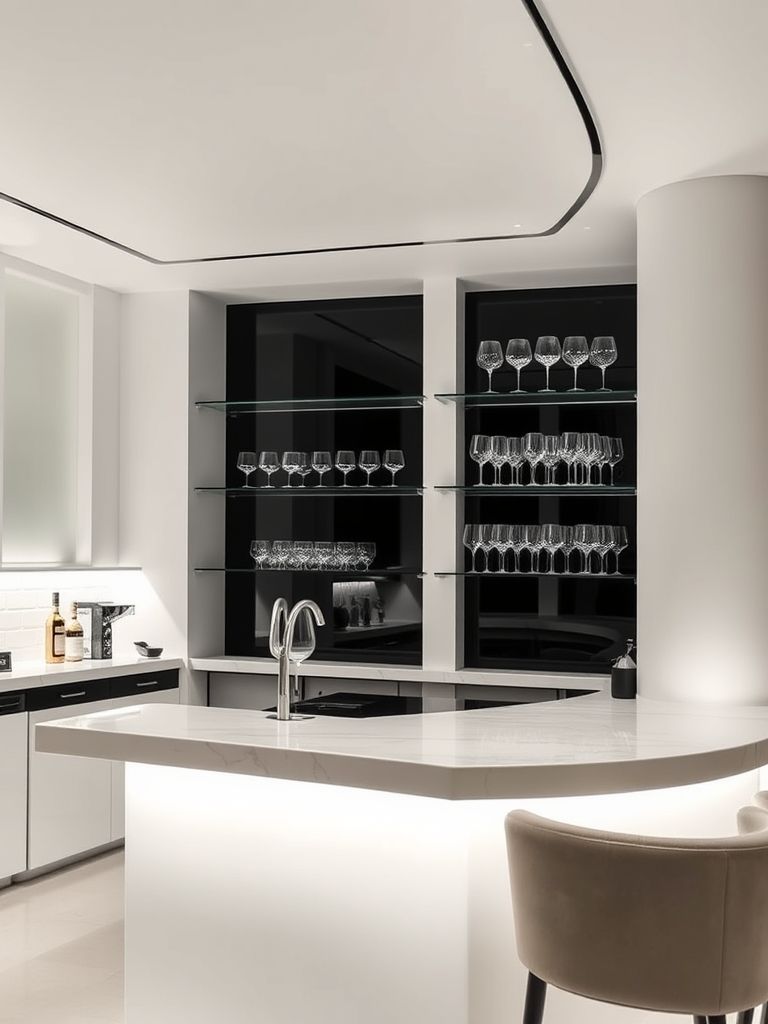
13) Modern Concrete and Metal Bar With Fire Feature
Anchor the composition with mass and line. Board-formed concrete for the bar base brings deep texture, while a powder-coated steel back bar adds crisp precision. Repeat the steel language in foot rails and shelf brackets so the materials feel intentional, not random.
Integrate a linear fire feature for drama. Set it parallel to the guest edge or perpendicular as a zone divider; either way, keep clearances from combustible seating and verify BTU, ventilation, and wind-rating specs. Propane offers flexibility; natural gas gives on-demand ease if you can plumb it.
Choose a working surface that handles heat. Ultra-compact sintered stone, sealed concrete, or basalt cope well with stray warmth from the flame. If you crave wood’s feel, inset a removable hardwood cutting slab into the concrete top so the “soft zone” can be swapped when worn.
Light like a gallery. A narrow beam spotlight over the fire traces flame without glare, linear LEDs under the counter graze the board-form texture, and a single oversized metal pendant at the sink grounds the scene. Put the fire and accent lights on separate dimmers for fine control.
Plan for weather and wear. Penetrating sealers on concrete resist stains while preserving a natural sheen; tiny nylon pads quiet every metal-to-stone touchpoint. Add a wind screen or low glass guard to stabilize the flame on breezy nights and protect fingers reaching for drinks.
Keep the vibe comfortably stark. Monochrome barware, matte black tools, and charcoal textiles reinforce the palette. A single sculptural plant—olive, agave, or horsetail reed—delivers life without softening the architecture’s confident edge.
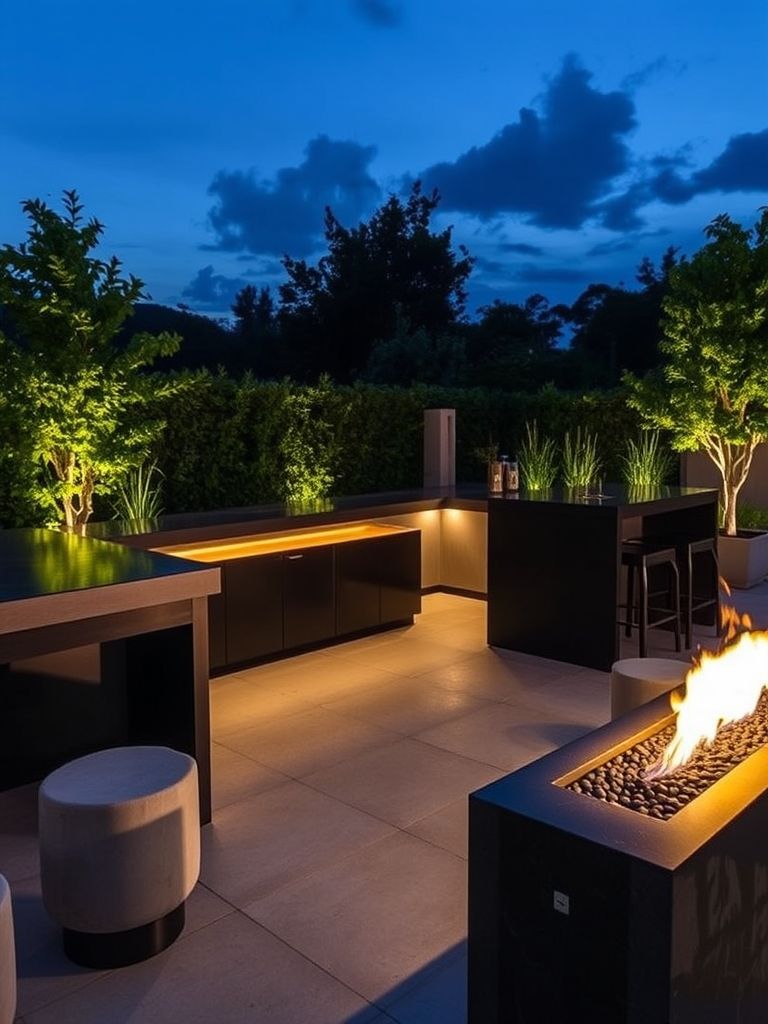
14) Outdoor Bar With Coastal Nautical Theme
Build the mood with materials that whisper shoreline. Teak or ipe for counters, white beadboard or shiplap for faces, and rope or cane details on stools nail the look. Layer in brushed brass or marine-grade stainless hardware that will patina gracefully with salt and sun.
Stick to a tide-washed palette: whites, sea glass blues, navy accents, and driftwood grays. Stripe a cushion or two, but keep patterns restrained so the space reads breezy rather than busy. A sisal-look outdoor rug frames the zone and adds barefoot comfort.
Borrow quietly from the boatyard. Use cleats as towel hooks, a ship’s bell as a playful service cue, and a length of authentic dock line as a foot rail wrap. Vintage charts behind acrylic or a brass porthole mirror above the back bar add character without kitsch.
Design for corrosion resistance. Choose 316 stainless screws and fittings, avoid dissimilar-metals contact where possible, and isolate hardware with nylon washers. Rinse hardware after salty days, oil teak periodically, and ventilate cabinets so damp doesn’t linger.
Serve like a beach club. Stock crisp whites, spritzes, citrusy mocktails, and shellfish-friendly lagers. A pebble-ice bin, citrus press, and chilled coupe rack make light, refreshing drinks effortless; a small enamel tray corrals seashell picks and stirrers.
Finish with lantern glow. Candle-style LED lanterns, caged sconces, and a few low path lights toward the lawn create a safe, romantic perimeter. Keep sound subtle—portable speaker tucked into a louvered niche—so waves (or the nearest fountain) stay the soundtrack.
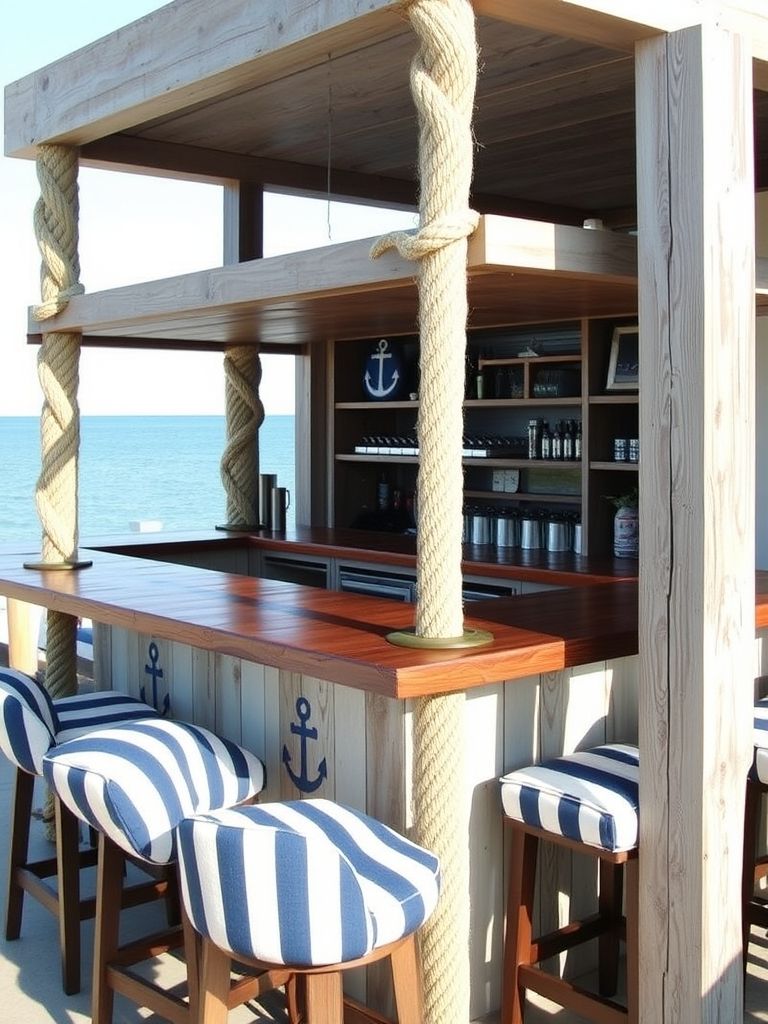
15) Outdoor Bar With Pizza Oven and Charcoal Grill
Map the “hot line” first. Place the pizza oven downwind and slightly offset from the primary bar seating, with the charcoal grill beside it to share prep and ash management. Keep at least 36 inches of noncombustible counter between appliances for staging peels and trays.
Vent like a pro. A flue or chimney with proper clearance and a spark arrestor keeps smoke moving up, not through the lounge. If you’re under a pergola, add a heat shield above the oven mouth and confirm local code for overhead clearances and ember control.
Break the station into zones. A fire-safe stone or steel landing immediately by the oven, a cool zone with marble or stainless for stretching dough, and a wet zone with sink and tool rinse make service smooth. Under-counter pullouts hold flour bins, oven tools, and grill accessories.
Choose surfaces that shrug off heat and mess. Sintered stone and stainless next to appliances, sealed hardwood or butcher block farther away for plating. Add a built-in crumb chute and a brush drawer so clean-down between pies takes seconds.
Make fuel handling painless. A steel bin with a tight lid stores lump charcoal; a separate metal ash bucket on a paver pad handles cleanout. Keep kiln-dried splits for the oven in a ventilated rack, and a moisture meter nearby so you’re not guessing.
Design for showtime and cooldown. A long, guest-side ledge invites spectators without crowding the cook; clip a small digital timer rail to track multiple pies. After service, a hinged tool bar, heat-proof glove cubby, and stainless peel slot tidy the face so the bar returns to cocktail duty fast.
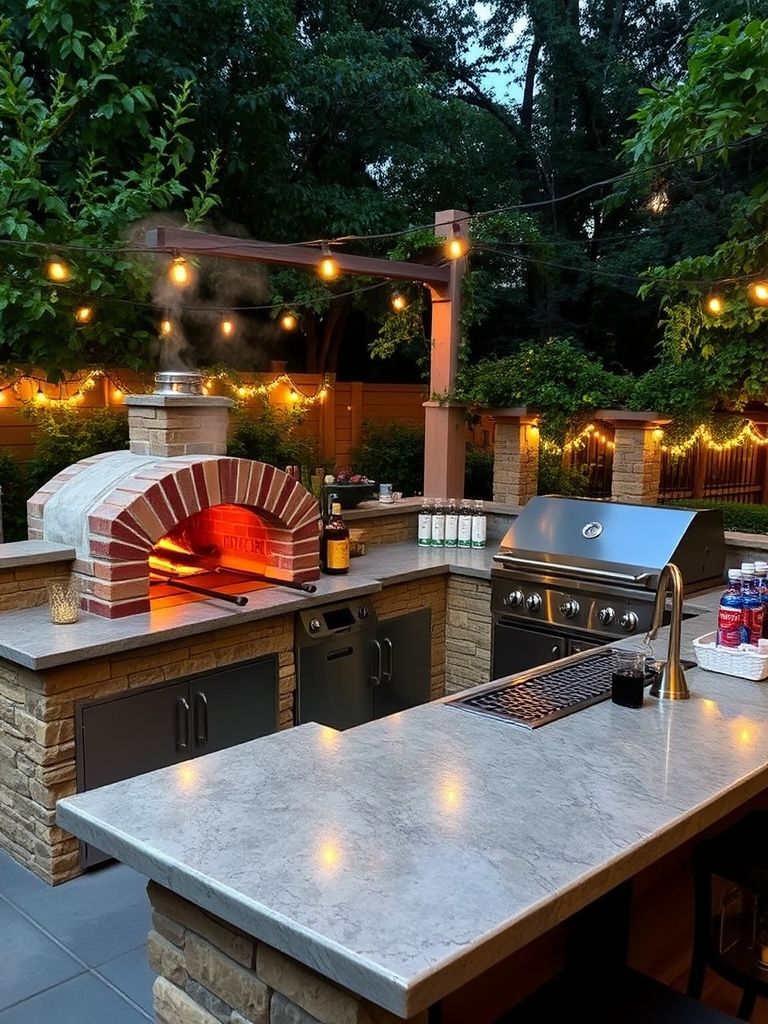
16) Pergola-Covered Outdoor Bar With Hanging Glass Rack
Start with a sturdy frame sized to your bar footprint. 4×4 or 6×6 posts in galvanized brackets keep the pergola rigid; use doubled 2×8 beams for longer spans and stainless or powder-coated hardware so the structure ages gracefully outdoors.
Tune the shade to your climate. Fixed slats set at a consistent angle soften sun without going dark; add a retractable canvas or polycarbonate panel if you want rain cover without heavy visuals. A slight roof pitch and hidden gutter line will keep drips off the counter.
Make the hanging glass rack a hero feature. Mount it between beams with through-bolts, not screws, and use marine-grade cable or rod for support. Stagger channels for rocks, wine, and coupe glasses so you’re not hunting in the middle of service.
Layer task and mood lighting. A pair of compact pendants over the prep zone, a dimmable LED strip under the rack to sparkle stems, and low, warm downlights on the posts create depth at night. Add a simple dimmer so you can swing from dinner to late-night lounge.
Keep weather in mind for every material choice. Choose 304/316 stainless for the rack, sealed hardwood or sintered stone for the counter, and exterior-rated finishes on all wood. A discreet slot drain behind the bar catches rinse water and rain splash.
Green it up without inviting mess. Train jasmine or star grape along the outer pergola edges for scent and softness, but keep vines off the rack zone so pollen and leaves don’t drop into glassware. A narrow planter ledge at stool height doubles as a standing drink rail.
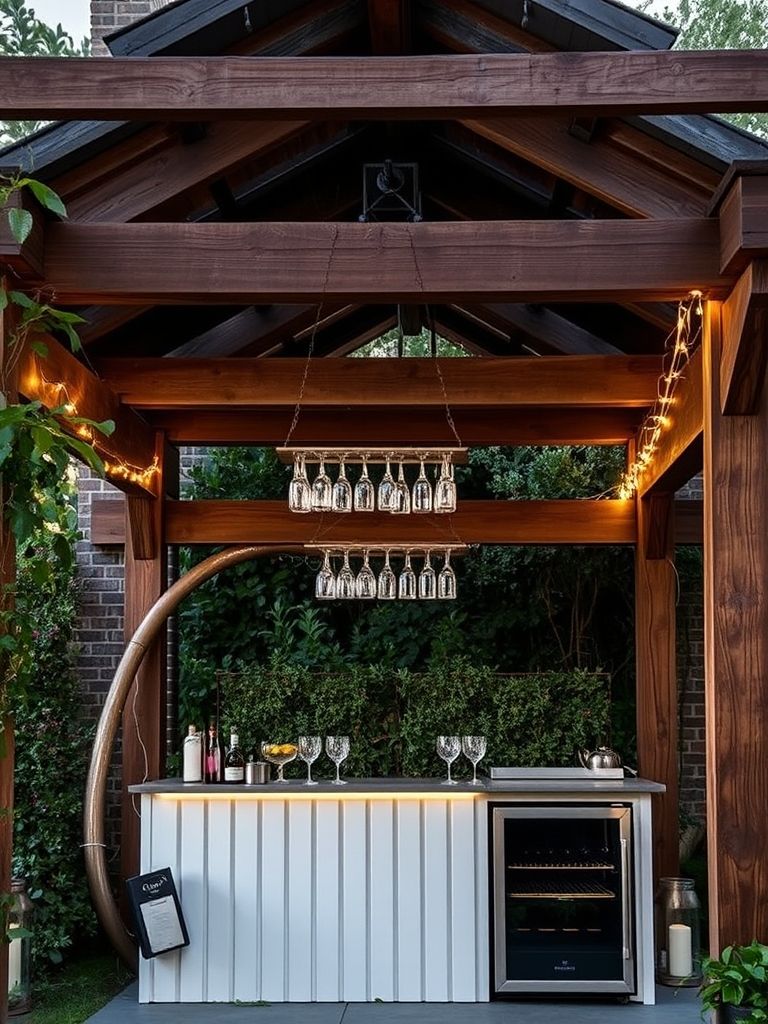
17) Poolside Bar With Swim-Up Counter and Stone Finishes
Plan the bar as part of the pool, not an add-on. Align the swim-up counter with a dry-side service ledge so drinks pass easily between zones, and keep a clear path from house to bar that doesn’t cross wet deck traffic.
Design underwater seating for comfort and safety. Built-in submerged stools should sit 12–15 inches below the waterline with rounded edges and a textured finish for grip. Keep a 24–30 inch knee clearance under the counter so swimmers can perch naturally.
Choose stone that handles splash and sun. Flame-finished granite, quartzite, or porcelain pavers resist chlorine and heat while providing traction. Use a bullnose or eased edge at the waterline and a drip groove under the guest edge to keep run-off off laps.
Separate hot and wet zones. Keep the ice well and fridge on the dry side, with a dedicated rinse sink for glassware; use lidded caddies for garnishes to protect from splashes. Towels live in a ventilated cubby just outside the spray zone.
Light it for magic after dark. LED niche lights under the swim-up counter, small step lights along the coping, and warm pendants on the dry side turn the area into a glowing cove. Put pool and bar lights on different circuits to tune the vibe.
Mind code and hygiene. Use GFCI outlets, non-slip deck surfaces, and furniture that won’t float if kicked. Keep sanitizer tabs and a skimmer on standby near the bar, and store electrical drivers well away from the splash radius in a ventilated, weather-sealed cabinet.
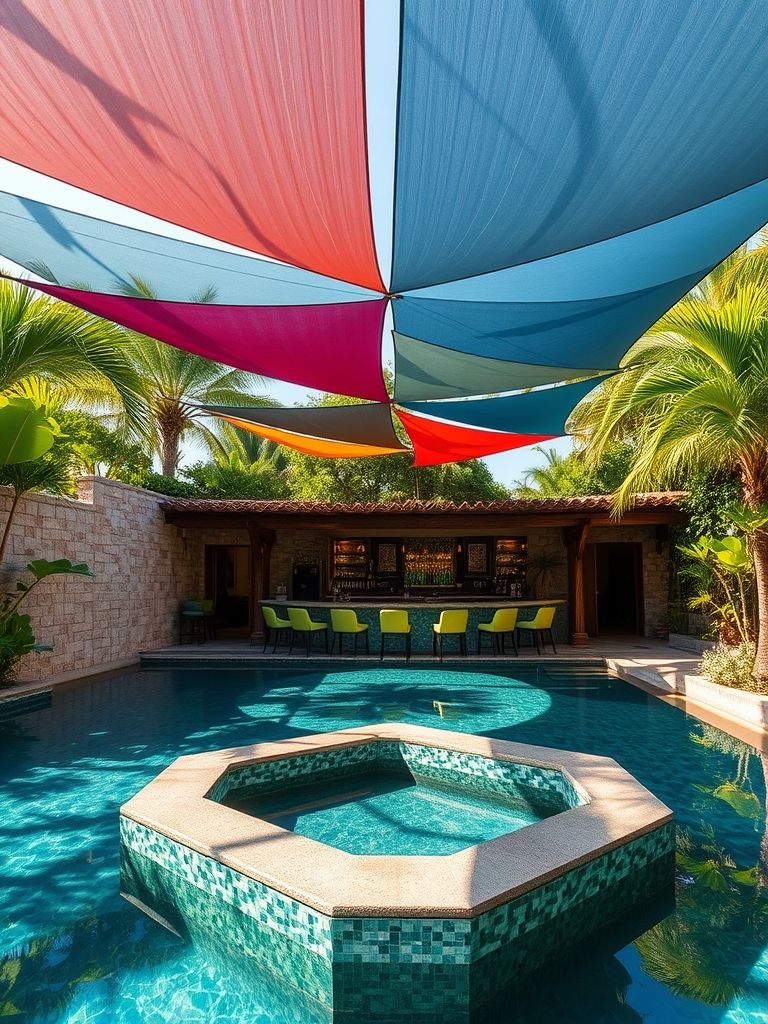
18) Rustic Wood Pallet Bar Under String Lights
Lean into texture and warmth. Build the face from staggered pallet slats in mixed tones, then frame corners with black angle iron for a finished, barn-meets-backyard look. A thick, oiled hardwood top adds a human, hand-rubbed feel to every pour.
Make the lighting do the talking. Hang two bistro-style string-light runs in gentle swags overhead, then add a few down-facing bulbs right above the counter for sparkle in glassware. Keep the bulbs warm (no blue hues) so the wood’s grain glows at night.
Organize the back bar like a farm pantry. Crates and wire baskets hold fruit, snacks, and bar towels; a simple peg rack keeps openers and towels at hand. A galvanized tub in a wood cradle is your all-purpose ice chest for beer and sodas.
Protect what you love. Seal pallet slats with a UV, water-repellent finish and set the bar on hidden composite shims to keep wood off damp pavers. A snug canvas cover and a quick wipe-down before service will make the setup feel fresh every time.
Keep tools humble and reliable. Enamel trays, mason jars for garnishes, and a heavy, no-nonsense shaker fit the vibe. A chalkboard for the night’s pours and a vintage bell for “order up” give guests a role in the ritual.
Finish the scene with casual seating. Mix backless stools at the counter with a couple of low camp chairs and a rug that frames the zone. A small fire bowl or lantern cluster just beyond the bar extends the evening without stealing the spotlight.
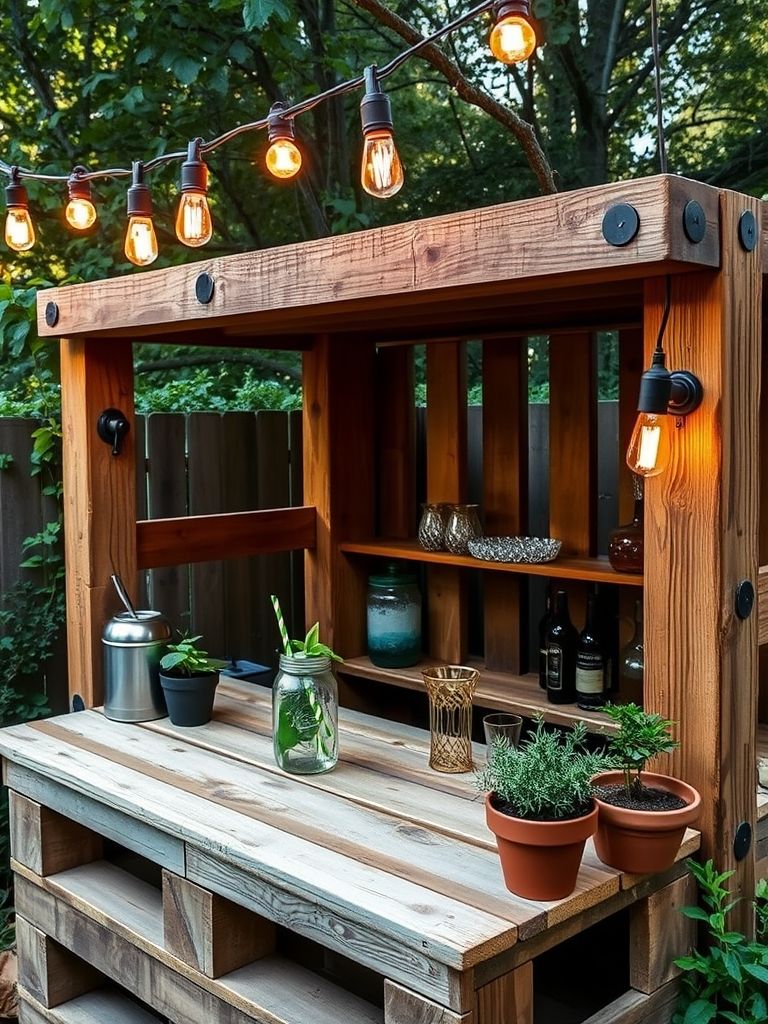
19) Sports-Themed Outdoor Bar With Mounted TV and Keg Tap
Start with sightlines. Mount the TV at eye level from the primary seating lane (typically 42–48 inches to center when seated) and angle it slightly downward to fight glare. If sunsets hit hard, add a side shade or choose a high-brightness, outdoor-rated display.
Weather and wiring matter. Use an outdoor TV or fully sealed enclosure, run power and signal in conduit, and terminate at a weatherproof box with GFCI. Tidy everything with a recessed cable plate behind the screen so you’re not staring at wires on game day.
Build a keg system you’ll actually maintain. A dedicated kegerator with stainless shank and tap, CO₂ tank secured in a vented cabinet, and insulated beer line keeps pours crisp. Add a drip tray with drain, a line-cleaning kit, and quick-disconnects so upkeep is painless.
Design the bar like a small fan zone. A long ledge for plates, easy-wipe counters, and hooks for team scarves and caps keep energy high without clutter. Swivel stools let guests pivot between screen and conversation without scooting chairs.
Sound is half the experience. Weatherproof left/right speakers mounted under the overhang beat TV speakers by miles; add a compact sub tucked in a ventilated cabinet for crowd-roar oomph. Keep volume civil and direct the speakers toward the seating, not the neighbors.
Lean into team spirit tastefully. Neutral base palette, then swap team flags, coasters, and a scoreboard-style chalk panel by season. A slim shelf for remotes, spare batteries, and a universal charger saves the “where’s the clicker?” scramble at kickoff.
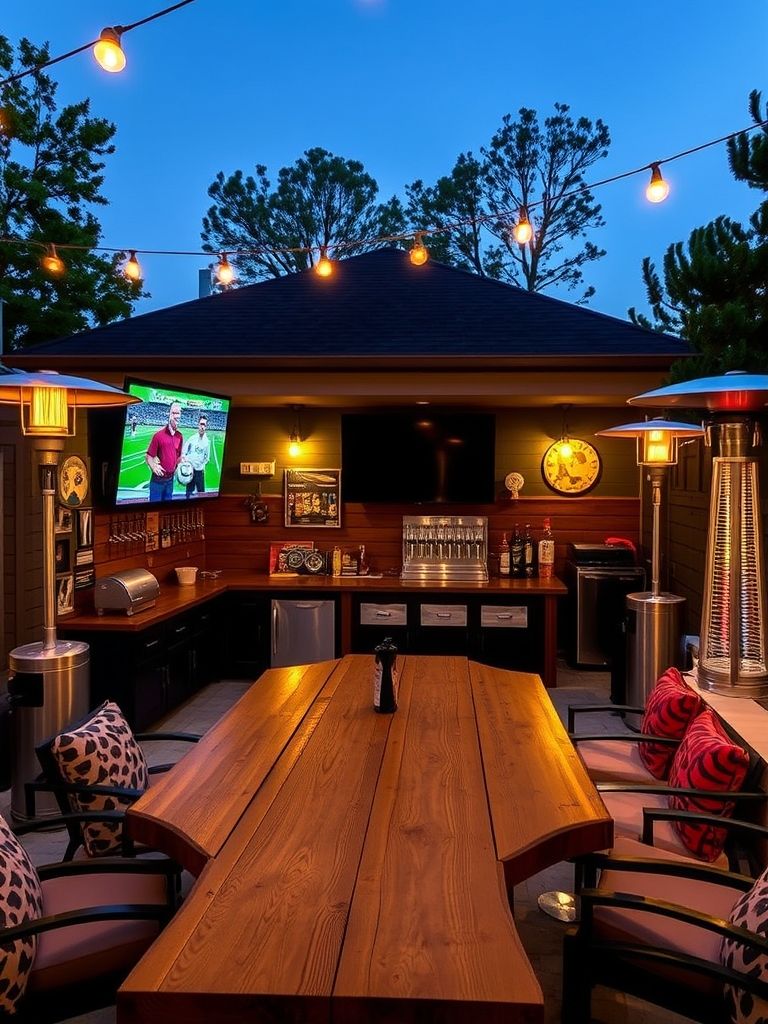
20) Tropical Tiki Bar With Thatched Roof and Bamboo Accents
Get the roof right first. A thatched canopy delivers instant escapism, but consider synthetic thatch for longevity, fire resistance, and fewer pests. Pitch it steeply so rain sheds fast, and extend generous eaves to shade the guest edge of the counter.
Build with real-deal tiki textures. Use split bamboo for fascia, knotted rope lashings at posts, and a carved tiki or two for punctuation—then stop so it feels curated, not costume-y. A stained, water-resistant wood top or sealed lava stone keeps the tactile vibe without fuss.
Light like a torchlit cove—safely. Swap open flame for LED “flame” lanterns and low-watt path lights tucked into planters. A warm strip under the counter lip highlights bamboo weave and makes menus readable without killing the mood.
Stock a playful, island-leaning menu. Fresh-pressed lime, orgeat, demerara syrup, and bitters unlock classics; pebble ice and swizzle sticks make them irresistible. Offer zero-proof riffs with coconut water, pineapple shrub, and mint so everyone can join the fun.
Engineer durability behind the scenes. Use stainless fasteners isolated from bamboo with nylon washers, ventilate cabinets to avoid trapped humidity, and keep a dehumidifying desiccant tub in the main storage bay during the rainy season.
Bring the sound and flora. Low-key steel-drum playlists, a discreet speaker tucked behind a screen of palms, and planters of bromeliads or bird-of-paradise complete the escape. Keep a hand broom under the bar—sand, thatch bits, and party confetti happen.
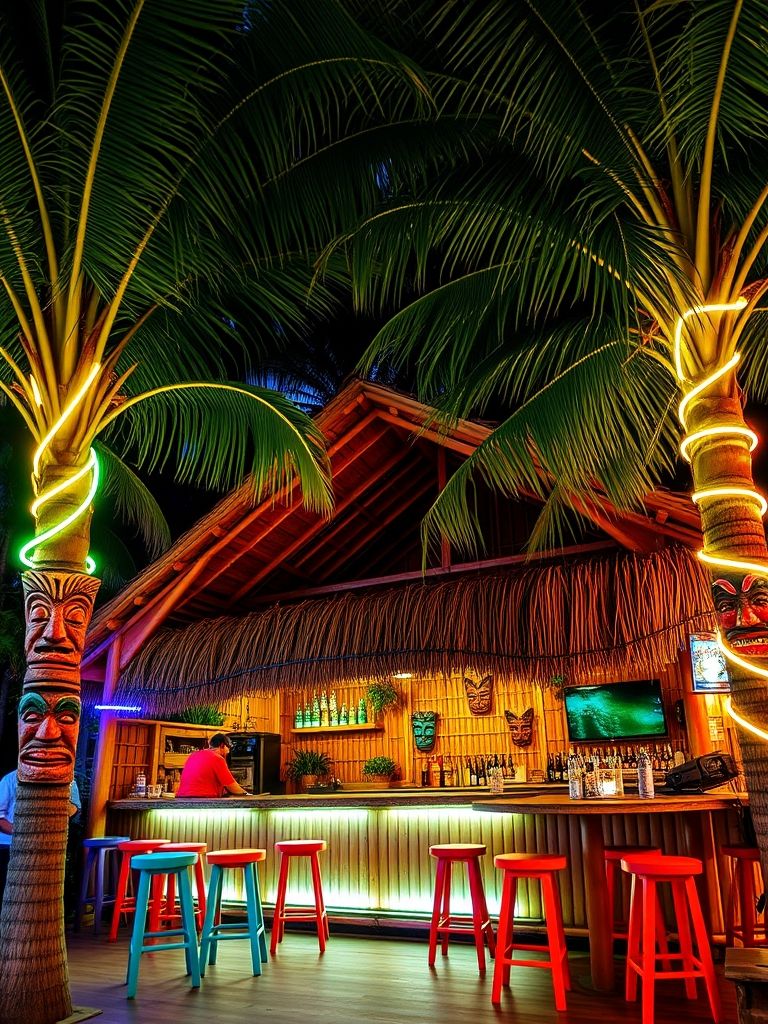
Conclusion
Building an outdoor bar that truly works is part theater, part workflow, and part weather science. Start by sizing the envelope and setting clear traffic paths, then choose a material palette that fits your climate and story—stone and glass for luxe, rope and teak for coastal, bamboo and thatch for tiki, concrete and steel for modern edge.
Light in layers so the scene reads beautifully after dark: safe footing, bright prep, and soft mood. Keep power and plumbing tidy, protected, and serviceable; a ventilated cabinet for drivers and CO₂ and a labeled shut-off for gas or water will save you later.
Design the working face like a compact kitchen. Sink, ice, and primary prep in a tight triangle; cold storage and trash just outside it; a shallow shelf or ledge for guests so the main counter stays clear. Add a couple of “wow” details—hanging glass rack, linear fire, herb wall—that fit your theme.
Plan for care with the same intent as design. Seal stone and wood on schedule, clean lines and taps regularly, and store textiles when weather turns. A simple cover, a brush, and a dedicated caddy of cleaning supplies keep the bar ready at a moment’s notice.
Finally, let the space flex. Daytime lemonade stand, sunset aperitivo, big-game headquarters, or late-night s’mores station—great outdoor bars shift roles with ease. Build the bones right and every gathering will feel effortless, personal, and just a little bit magical.

